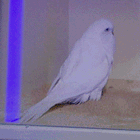Don visited Dr Justin Marshall at the University of Queensland’s Department of Vision, Touch and Hearing. Dr Marshall and his colleagues have discovered that the ultraviolet pigments on budgerigars’ feathers play a big role in their attractiveness to members of the opposite sex.
Why budgies glow
Budgies have feathers on their cheeks and the crowns of their heads which reflect ultraviolet light and which are prominent in courtship display. Because budgies have 4 types of colour sensing cells in their eyes (humans only have 3), they are able to see into the ultraviolet (UV) spectrum. So to a budgie, the pigmented feathers appear very bright.
University of Queensland study
Some budgies in the study had petroleum jelly with sunscreen smeared on their heads. The sunscreen stopped the UV light being reflected by the feathers, but did not block other colours. The control group had petroleum jelly smeared on their heads without the sunscreen. Female budgies had to choose between slick-headed males with UV colour and slick-headed males without UV colour. The hens showed a distinct preference for males without sunscreen.
Many birds, particularly brightly coloured members of the parrot family, have UV pigmented feathers, but this is the first documented case of ultraviolet sexual signalling.
Looking at budgies under UV light
To find out what happens to budgies under UV light, Don set up an experiment in his shed. First he constructed a glass-fronted cage and painted it a neutral, beige colour.
He placed different coloured budgies in the cage, turned the shed lights off and looked at each budgie under UV light. Although humans don’t see ultraviolet very well, a UV light will cause UV pigments on the budgies to fluoresce in a dark room. The invisible becomes visible. The light green, wild coloured budgerigar had bright fluorescing feathers. Lutino or uniformly yellow budgerigars also fluoresced very brightly. However, blue and albino budgies (which don’t have any yellow pigment) did not fluoresce at all under the UV light. A black-eyed yellow baby budgie with immature plumage showed some fluorescence, but it was nowhere near as bright as that of either the male or female adults.
Implications for budgie breeders
If you keep budgies in a mixed aviary, remember that the blue budgies are much less likely to find mates than the green ones, so you’ll breed more green or yellow budgies. Serious breeders overcome this problem by placing one pair of budgies in a cage, instead of allowing them to choose their own mates. A pair of blue budgies will breed very well, but given a choice they would always prefer to mate with green type budgies.
Further information
We filmed our segment with:
Dr Justin Marshall
Dept of Vision, Touch and Hearing
University of Queensland
St Lucia, Brisbane
Phone: (07) 3365 4071



